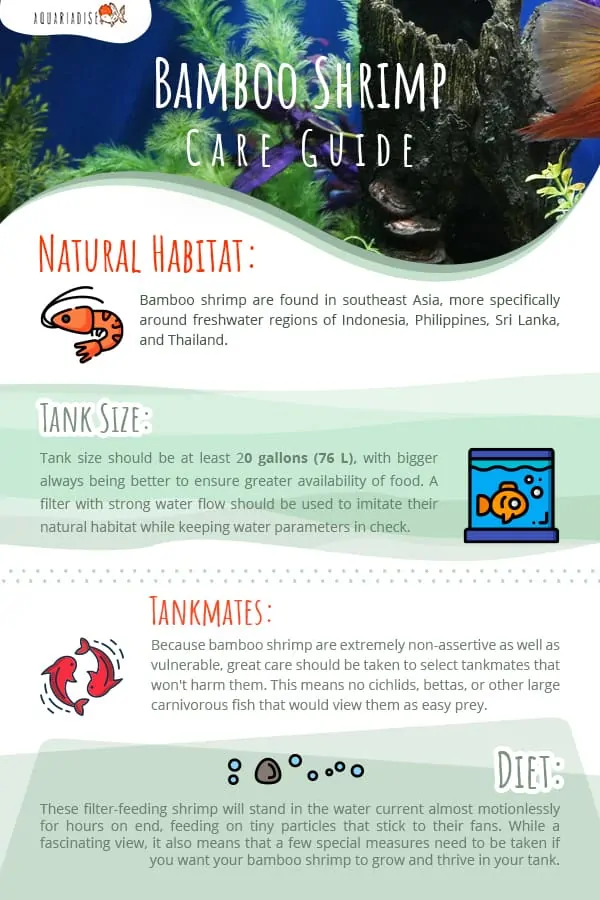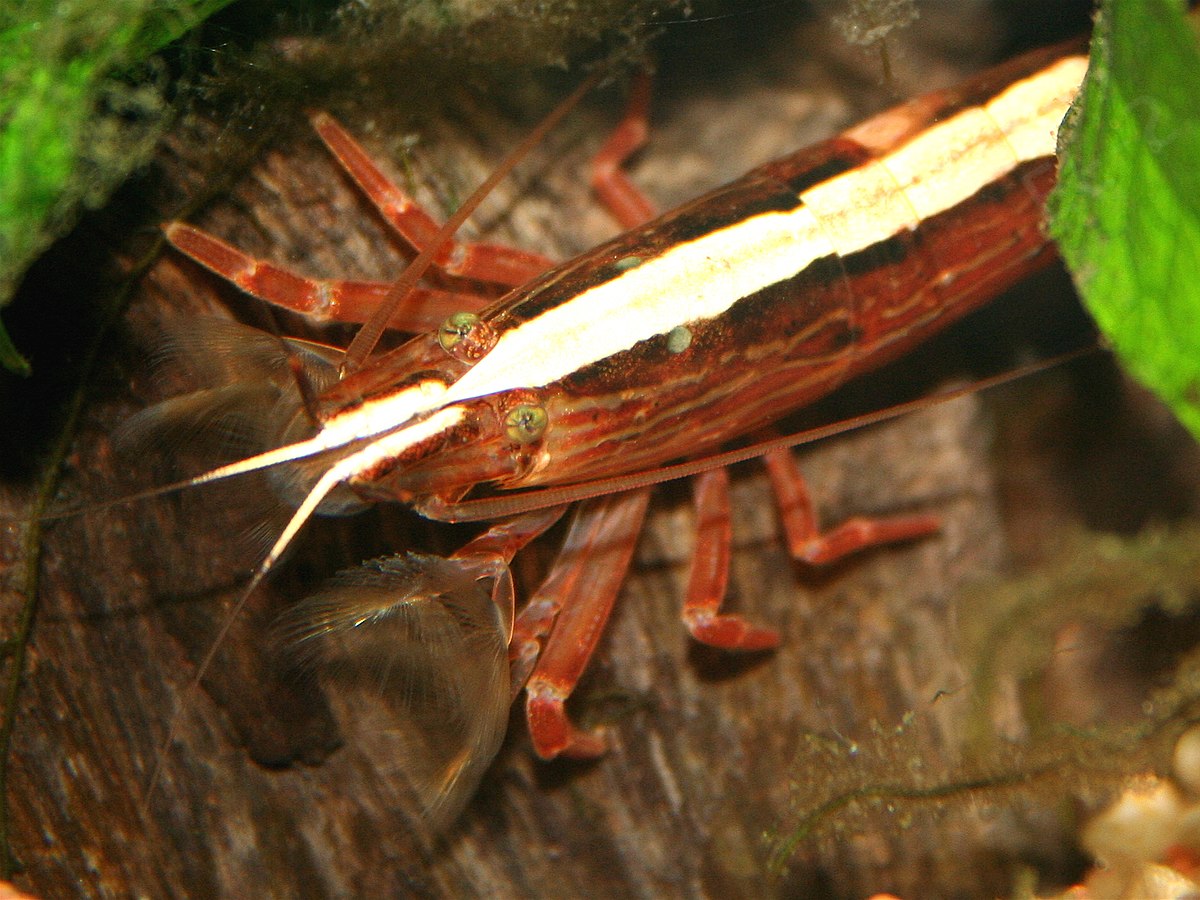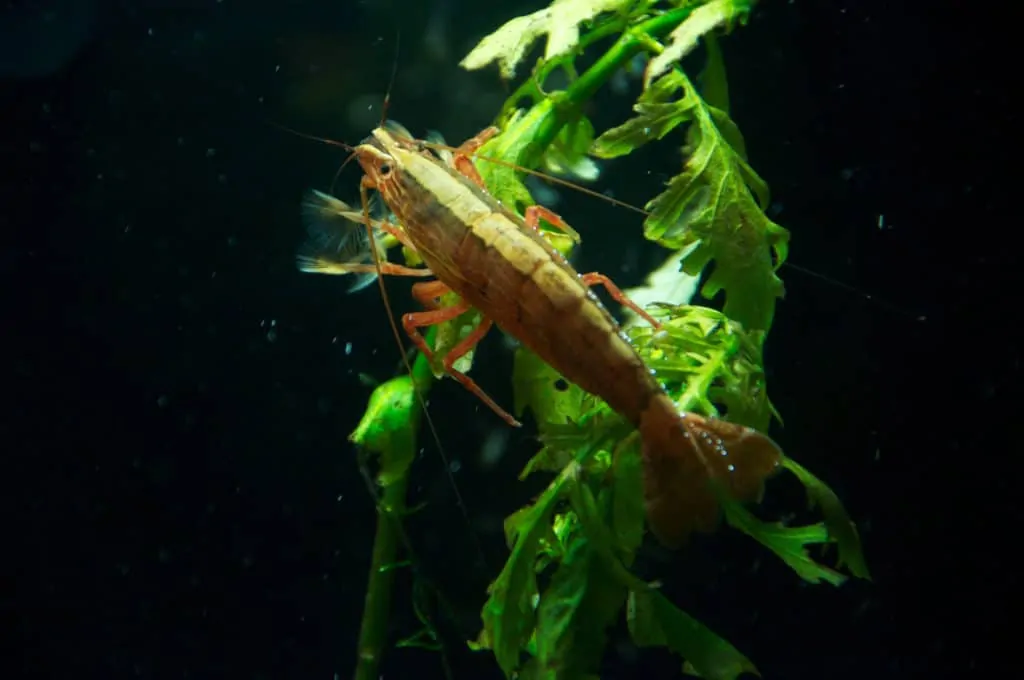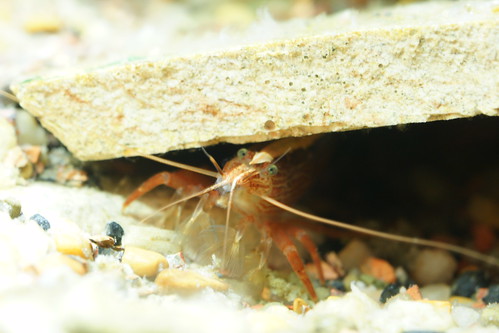This filter-feeding shrimp is one of the most interesting aquarium shrimp available in the freshwater hobby, courtesy of its unusual feeding method. Unlike most other shrimp, bamboo shrimp are not bottom feeders. They use fan-like appendages to filter particles out of the water. This calls for an entirely different feeding method, but luckily, successfully caring for these shrimp is not too hard if you know what you’re doing!
Keep reading for everything you need about bamboo shrimp care and keeping bamboo shrimp in your own aquarium.
Note: You can buy bamboo shrimp online here!
| Minimum tank size | 20 gal/76 L |
| Temperament | Peaceful |
| Diet | Detrivore |
| Temperature | 68-77 °F/20-25 °C |
| pH | 6.5-7.5 |
Name
Atyopsis moluccensis is commonly known as bamboo shrimp, wood shrimp, the fan shrimp, Singapore flower shrimp, or simply as Singapore shrimp. Bamboo shrimp belong to the genus Atyopsis (formerly Atya), with only one other species, Atya spinipes. Not much information exists on either species and their natural range is still very confined without external influence.
Natural Habitat
Bamboo shrimp are found in southeast Asia, more specifically around freshwater regions of Indonesia, Philippines, Sri Lanka, and Thailand. They inhabit inland streams coming from the mountains and hills with high flow and hide under submerged roots and rocks where it is safe to filter feed. Interestingly, they tend to stay away from the banks of the water.
Despite its popularity across Asia, Europe, and the United States, it’s difficult to find documentation on when bamboo shrimp were first introduced into the home aquarium hobby. Even with such high demand, there have been no traces of release back into the wild so their native range in Asia has remained intact.

Identification
With their reddish-brown color and creamy white stripe that runs along their back, bamboo shrimp are a decorative addition to the aquarium. At times, they may also change to hues of brown, green, and yellow, which is normal. Their most striking feature, though, is the large feathery ‘fans’ used to filter particles out of the water to feed.
With an average size of around 2-3 inches (5-7.6 cm), and a maximum size of over 4 inches (10 cm), these shrimp are significantly larger than dwarf shrimp. If attempting to breed bamboo shrimp, it is important to note that females are larger than males and have smaller front legs.
Bamboo shrimp requirements
Although bamboo shrimp are relatively easy to keep, their feeding method does require the aquarist to take a few extra measures to ensure they don’t end up starving. Tank size should be at least 20 gallons (76 L), with bigger always being better to ensure greater availability of food. A filter with strong water flow should be used to imitate their natural habitat while keeping water parameters in check.
A tank that replicates hillstream conditions with coarse substrate and boulders would be ideal for this species. Provide a perch, like a piece of tall wood or rock, in a high current spot so your bamboo shrimp can use it as a feeding location.
Bamboo shrimp like to have access to a peaceful hide to stay in between feeding sessions. Additionally, like all shrimp, Atyopsis moluccensis regularly molt in order to grow. They shed their exoskeleton to reveal the new one that has been forming underneath. Right after molting, the new exoskeleton is still soft and the vulnerable shrimp will go into hiding for a few days until it has properly hardened. Be sure to provide an environment with plenty of hiding spots (such as shrimp flats) that your bamboo shrimp can use as a ‘home’ and retreat to while molting.
It is also very common to see aquarium keepers fill their bamboo shrimp tank with lots of plants. Plants will naturally create additional food for your shrimp and provide additional hiding spots. If using plant fertilizer, make sure that it is shrimp safe. Plant fertilizer pellets tend to sink to the bottom, where they dissolve slowly into the water. However, if your bamboo shrimp quickly ingests some of this plant fertilizer if the substrate is unsettled, it could prove to be fatal. So while plants are greatly appreciated, just make sure you can keep both your greens and your shrimp alive with proper care!
Note: Like all plants and invertebrates, bamboo shrimp are also susceptible to any traces of copper introduced to a tank.
How long do bamboo shrimp live?
While there is little information on these shrimp, they can be expected to successfully live 2-3 years in an aquarium with compatible fish, good water quality, and appropriate water flow. Sometimes, the shrimp may die a few days after being introduced to your tank. While this is usually caused by stress or an already existing illness, it is first recommended to double-check your water parameters and fish compatibility before adding more shrimp to your aquarium.
Bamboo shrimp tankmates
Because bamboo shrimp are extremely non-assertive as well as vulnerable, great care should be taken to select tankmates that won’t harm them. This means no cichlids, bettas, or other large carnivorous fish that would view them as easy prey.
Peaceful species from this list (small tetras, catfish, and hatchet fish) and other harmless invertebrates, such as dwarf shrimp and snails, would make a good choice. It is important to keep in mind that your bamboo shrimp enjoy high water flow; any tankmates added should also be able to withstand a higher current throughout the tank. Maybe even consider a single-species biotope aquarium if you really want to enjoy this species! This will also give you the chance to show off your aquascaping skills with your bamboo shrimp adding a pop of color.
Also be sure to always keep your bamboo shrimp in groups, as they appreciate safety in numbers; always keep in mind what your tank size and filter can handle.
Bamboo shrimp diet
One of the more difficult aspects of bamboo shrimp care is their diet. These filter-feeding shrimp will stand in the water current almost motionlessly for hours on end, feeding on tiny particles that stick to their fans. While a fascinating view, it also means that a few special measures need to be taken if you want your bamboo shrimp to grow and thrive in your tank.
Common techniques include target feeding these shrimp by releasing (powdered) food just upstream so it flows right into their fans. They are omnivorous and will appreciate anything they can catch: baby shrimp food, algae powder, crushed fish flakes, or baby brine shrimp; anything that they can filter will be seen as food.
In addition to feeding them powdered food, many aquarium keepers like to simply squeeze their filter sponge into the tank. This releases a cloud of particles that bamboo shrimp absolutely love to feed on. Only do this if you have a stable cycle running in your tank that won’t cause your parameters to deviate from ideal conditions, though!
Bamboo shrimp behavior
These gentle giants are content in sitting under the flow from the filter all day long to catch food with their fans. In fact, if they get enough food from the flow, they may stay in place so long that algae may start to grow on their exoskeleton! Fortunately, this is harmless.
When you first get bamboo shrimp, they may be shy until they acclimate to their new home. However, if you have lots of hides and a large group, the new shrimp will typically become more comfortable after a short time. They also tend to be more active at night, so you could consider running a very gentle moonlight lamp over your tank to really see them in action.
Problems with bamboo shrimp
A healthy bamboo shrimp should spend most of its time sitting in the current and looking for things to feed on while they filter through the water column. Are you seeing your bamboo shrimp attempting to scrape food off the substrate using their delicate fans? This is a serious indication that it’s definitely time to increase feedings!
If you find your aquarium is getting dirty quickly with all that powdered food being circulated by high flow, try keeping a bottom clean-up crew to deal with the particles your bamboo shrimp miss. Amano shrimp work well for this and will cohabit peacefully with Atyopsis as they prefer similar conditions.

Breeding bamboo shrimp
Although breeding bamboo shrimp is possible, it’s a real challenge. Like Amano shrimp (and unlike the easier dwarf shrimp), they don’t hatch as small adults. Instead, they go through a larval stage during which they require brackish water to survive.
This means the larvae should quickly be transferred to brackish water (sources report 33 or 34 grams of salt per liter) after hatching and then stay there until they grow into adult bamboo shrimp; this especially holds true if the bamboo shrimp larvae are left with other fish that will quickly make food of your small shrimp! After this incubation period, the fry then need to be returned to freshwater. While breeding is certainly not an easy task, it’s definitely something to look into as almost all bamboo shrimp in aquarium stores are wild caught.
Here is larvae filter-feeding on top of another bamboo shrimp!
Buying bamboo shrimp
Although they are not as common as dwarf shrimp, you should be able to find bamboo shrimp at some aquarium stores. Be sure not to confuse them with their other filter feeding cousin, though: vampire shrimp (Atya gabonensis); vampire shrimp can be recognized by their blueish exoskeleton and large size. Atyopsis moluccensis will never look blue!
When purchasing a new bamboo shrimp, a few missing legs or other limbs is not much of a problem; their legs will grow back in time after each molt! It is ideal to look for bamboo shrimp that have an intense color and that are actively looking for food.
You can also order bamboo shrimp online here!
If you have any more questions about Atyopsis moluccensis or want to share your own experiences with this fascinating shrimp species in your tank, don’t hesitate to leave a comment below!




I’ve had bamboo shrimp for about 8 months. This is the first time I’ve had one have a difficult molt. His fan hand is stuck. Should I be concerned?? The rest of his limbs and body are free from the exoskeleton.
Hi Alyssa!
That is pretty concerning! I would not intervene though as I think the shrimp is just too delicate. And hopefully, the molt will fall off or correct itself next time.
I would maybe supplement some calcium into your system as this could be a sign of an underlying problem. You can use eggshells, cuttlebone, or a special aquarium calcium liquid for dosing.
I hope everything goes well!!
Ive had my Bamboo`s for a few weeks, in a planted tank and ive yet to see them perch with fans out. Doesn’t matter if i shake a plant of detritus into the water column or any other simulation. They always, always plough through the Christmas moss that covers the floor (200 Ltr). Honestly, their like three little combine harvesters going along. They will then meet up in the shade, i dont know, to discuss bragging rights i guess. Then move onto another strip of moss. If there is one tip i would give, insist on a piece of plant or something soft, to be put in the bag for the shrimp to cling onto. After transportation i found the shrimp clinging to each other and almost turned translucent with stress. They survived but at £10 a pop you want them to.
Thanks for sharing your experience, Christmas and other moss sounds perfect for these shrimp because they can use it to forage without damaging those delicate fans. I would guess that the moss provides enough food for them not to want to bother sitting in the stream catching some particles here and there, but I’d suggest to keep trying now and again anyway just to be sure.
Good luck with them! I honestly just love the species, so entertaining 🙂
I should add that Woody had no problems or visible damage after picking for food on the bottom.
Also,although I have never read about it from any other sources, I have observed my neocaridina shrimp actively fan-feeding in the filter flow as well! Perhaps if they can do both that and raking the bottom without injury or issue, the larger species can as well?
I had one of these fellows for a short time before he decided to evacuate the aquarium one night… it was sad to find him a week later, but these things happen. So, an important point – as with most shrimp, keep a tight lid on the aquarium!
I had Woody in two aquarium setups. The first was a 20 gallon tank with a lot of rockwork and a few plants. I didn’t see him very often in this setup, and I assume that he mostly stayed hidden in or on the backside of rocks, coming out at night to feed.
When I moved my setup into a larger 35 gallon tank however, he would be out and about any time you looked! This tank had lots of branches and driftwood in it, and I’ll assume that the “wood” part of “wood shrimp” is a strong indicator as to how they prefer their environment! He was able to camouflage himself by hugging tight to branches, and seemed to divide his time between hanging out in the filter flow and hiding or resting away from the moving water. Tankmates included apple snails and platies, which were fine, and a betta for a short period of time, during which he remained hidden during the day.
There is a lot of information stating that it’s bad for these shrimp to rake the gravel, but I found when I first introduced him to my tank, despite there being plenty of “floaters” present, he would cheerfully pluck at detritus on the sand bed, carving a swathe of clean sand across the bottom and leaving a trail of tiny round poops as he went.
My recommendations for keeping this shrimp are: Lots of wood and branches to help it feel secure during the day, a strong current (if you can side-mount your filter output you’ll be able to observe much more wood shrimp action), a mature tank of at least 30 gallons (they are extremely efficient fan-feeders), and a team of smaller shrimp or substrate-sifting fish to kick up a constant stream of edible bits into the water column.
Thanks for sharing, those are some great tips 🙂
As for the fans being damaged by foraging on the ground, I have seen fan shrimp with damaged fans at aquarium stores. It might have something to do with the type of substrate, you mention sand – they were always on sharp gravel.
Thanks again!